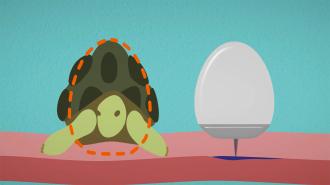MIT researchers have devised a way to deliver RNA vaccines and other nucleic acid therapeutics in pill form — potentially making them easier to distribute and more appealing to people with a fear of needles.
The drugs: Nucleic acids are found in every cell in our bodies. The two main types, DNA and RNA, are responsible for storing and expressing genes.
Nucleic acid therapeutics — such as the DNA and RNA vaccines against COVID-19 — use these molecules to deliver instructions to our cells to make proteins that can help fend off disease.
An estimated 1 in 4 adults has a strong fear of needles.
The challenge: Nucleic acid therapeutics are notoriously difficult to administer — RNA degrades especially rapidly — so they typically have to be packaged in a protective particle and delivered via an injection.
A pill, on the other hand, would have to go through the digestive tract, where stomach acid ordinarily dissolves any RNA or DNA into useless fragments.
An estimated 1 in 4 adults has a strong fear of needles, and the CDC predicted that as many as 1 in 10 people might delay getting a COVID-19 vaccine due to this fear.
The capsule: In 2019, MIT researchers unveiled a capsule designed to orally deliver insulin, and in 2021, they tweaked the design to orally administer large molecules, such as monoclonal antibodies, in a liquid form.
They’ve now demonstrated that each pill can deliver up to 50 micrograms of RNA, coated in a special nanoparticle, into pigs’ stomachs. (For comparison, the approved RNA vaccines for COVID-19 only need to contain 30 to 100 micrograms of RNA.)
“Overcoming [RNA’s sensitivity to degradation] opens up multiple approaches to therapy, including potential vaccination through the oral route,” senior author Giovanni Traverso told MIT News.
How it works: The capsule is about the size of a blueberry, and it contains a very tiny needle attached to a compressed spring. A pellet of sugar holds the needle in this position until it reaches the stomach — the sugar then dissolves, and the spring pushes the needle out.
The capsule’s shape was inspired by the shell of a leopard tortoise, which is domed in a way that allows the animal to right itself if it ends up on its back. The shape ensures that the needle is always pointed against the stomach lining, where it can deliver its RNA to cells.
According to the 2021 study, the needle retracts into the capsule after delivering its payload, and the injections — which penetrated about 4.5 millimeters into the pigs’ stomach lining — didn’t cause any damage to the tissue.
The impact: Using a “reporter protein” delivered via the RNA, the researchers were able to see where the RNA ended up in the pigs’ bodies, and it never left the cells of their stomachs. In an experiment with mice, the protein was expressed in the stomach and liver.
The team thinks it may be able to increase the uptake of the molecules in other organs by either using larger doses of RNA or changing their nanoparticle coating, but that wouldn’t be necessary if a nucleic acid therapeutic was targeting a gastrointestinal disease.
“Stimulating the gastrointestinal tract’s immune system is a known way of creating an immune response.”
Alex Abramson
It might not be needed to effectively administer RNA vaccines, either.
“There are many immune cells in the gastrointestinal tract, and stimulating the immune system of the gastrointestinal tract is a known way of creating an immune response,” lead author Alex Abramson said.
The oral polio vaccine, for instance, is designed to stimulate immunity along the GI tract to prevent the virus from spreading.
But to find out for sure, they’ll need to study whether the capsules can trigger a systemic immune response — creating antibodies and immune cells throughout the body — when loaded with an actual mRNA vaccine.
The big picture: The MIT team isn’t the only group looking for ways to get needle-phobic people vaccinated against COVID-19.
Cambridge researchers launched a phase 1 trial of a needle-free vaccine delivered via a jet of fluid in December 2021, and Chinese researchers have developed a microneedle patch to deliver a DNA-based COVID-19 vaccine.
A clinical trial testing the efficacy of AstraZeneca’s COVID-19 vaccine when delivered as a nasal spray is ongoing, and India’s Bharat Biotech received approval in January 2022 to begin phase 3 trials of a booster vaccine delivered via the nose.
We’d love to hear from you! If you have a comment about this article or if you have a tip for a future Freethink story, please email us at [email protected].






